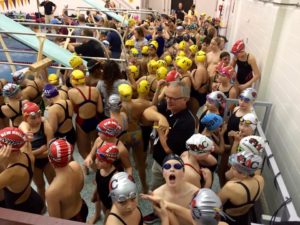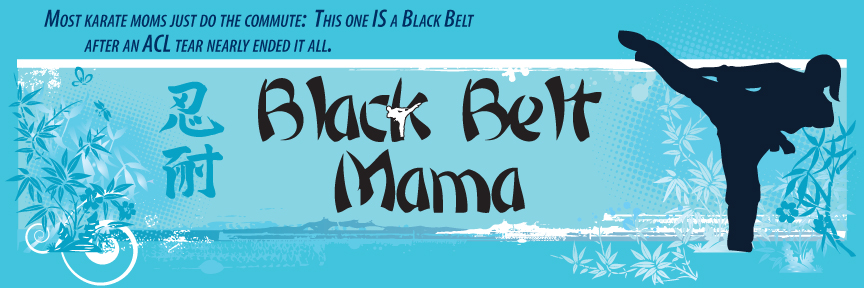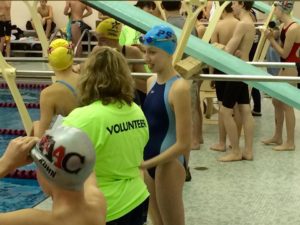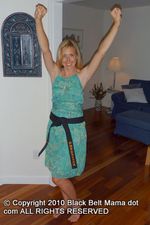Nintai…It Runs in the Family
The kanji design that is the heart and soul of this site has been my mantra for a long time. . . nintai. Persevere. It was the kanji hand painted onto the crutches that got me through three knee surgeries . It was the thought always in my head as I worked on flexion at PT and celebrated each accumulating degree. It was the motto of the move that took me away from my family, friends, swim team, and dojo. You just keep putting one foot in front of the other. You can get through anything if you just keep going.
So it seems only fitting that my 1000th post would be about perseverance as well. But today, I don’t want to write about all I have persevered through. Instead, I’d like to write about Swim Girl, my senior in high school, my beautiful, smart and talented 17-year old who first made her “blog character” appearance 12 years ago, in 2006, as “Big I.” Although I took a writing hiatus, her early years were documented here. And during that hiatus, she has really grown up.
Swim Girl has always loved swimming, even when she was not so great at it. After moving to VA, she began trying some longer distance events and discovered that she was pretty good at swimming them. For a while, she continued to drop time in those events. I looked forward to her swimming the 1650 free, because it was fun to see how much time she could drop. And then the drops came to a halt. Swim Girl described the same thing after every race. She felt like she couldn’t breathe, that her throat was closing up, that there was a lump in her throat preventing her from breathing. It was during allergy season when she first described these symptoms, so I didn’t think much of it. She was diagnosed with exercise-induced asthma when she was younger. I figured the allergies were just exacerbating the asthma.
Then, just weeks before Senior Champs of her sophomore year, there was a chlorine chemical spill at her practice facility. Six of our swimmers had to go to the ER, including Swim Girl. She felt like her lungs had been fried. After ER breathing treatments and two rounds of steroids, she started to feel a little better. But her events at Senior Champs were nowhere near where they should have been time-wise. She entered her Junior year, hoping for better days ahead.
As her Junior year started, Swim Girl couldn’t help but wonder why she always seemed the most out of breath at practice. She had barely taken a break between seasons and was attending all practices. She started to feel frustrated, but thought that maybe the hot pool and air temp were contributing to her asthma difficulties. She never seemed to get the lanes with the “good air,” so she figured it was a combination of things and kept on going.
During an October meet, where she was put in multiple distance events, I watched her fade back in the 1650, her splits completely off of where she should have been, even for an early season meet. When she finished the race, she was purple. She described the same feeling again, and we decided we needed a doctor’s appointment to reevaluate her asthma inhalers and make sure that her lungs had healed from the chlorine spill. It was during this appointment that our pediatrician suspected Swim Girl was suffering from Vocal Cord Dysfunction. The tight feeling in her throat was her vocal cords getting a message from her brain to close instead of open when she needed to breathe most. We were referred to a pulmonologist to confirm the diagnosis.
After a pulmonary function test, we met with the pulmonologist and he confirmed that Swim Girl had a classic example of VCD. He showed us a pulmonary function test graph that indicates a diagnosis of VCD. He then showed us Swim Girls’. They were identical. At first, we were relieved to have some answers. I figured there was a medication they could give her and it would stop. But unfortunately, with VCD, that is not the case. There is no medicinal cure. To double-check that there was nothing else going on, the pulmonologist referred us to an ENT doctor and her team which included a speech therapist. They put a small scope with a camera into Swim Girl’s throat to see her vocal cords. The diagnosis was confirmed once again. In the absence of any visible problem, VCD was the culprit.
We were referred to a speech therapist so that Swim Girl could learn how to breathe in a different way to combat the VCD attacks she would get while swimming. We spent two months going to appointments, where she focused on “belly breathing,” and on learning ways to stop (or at least minimize) an attack when it happened in the water. The challenging part is that quick inhales (imagine trying to take a fast sip) while swimming can be counterproductive. Swim Girl’s speech therapist told her that she needed to slow down during practice until she had mastered the new way she had to breathe. “No,” she told him, “I’ll just figure out how to swim fast and do it.”
Instead of doing her “double” practices with her team, she began doing some of them on her own at the local YMCA so she could slow down and work on her breathing. Sometimes the breathing techniques worked and sometimes they didn’t. Sets with little rest were torture for her. Without having time to reset her breathing, she would end up spending an entire practice just trying to calm her breathing back down. Sometimes, she began seeing spots and feeling like she would pass out. Swim Girl’s speech therapist told her that stress can make VCD worse, so he worked with her on relaxation techniques as well.
Physically, she was struggling with trying to figure out how to implement her breathing techniques during certain strokes (breast and fly for example); and mentally, she was struggling too. Her speech therapist continued to encourage and pump her up, and she was attending at least 7 practices a week at this point AND was doing extra practices on her own at the YMCA plus working out with her trainer. At practice, she focused on backstroke since she had figured out the breathing for that stroke. She didn’t feel it was possible to try to figure it out with the other strokes, not at a team practice.
Swim Girl started doing her own research into her condition. There had to be something she could do that would help. She found research studies that cited a different inhaler having an impact due to its anti-inflammatory properties. We made an appointment with the doctor and Swim Girl presented the study and got her inhaler switched. She also read many articles about how many swimmers with VCD found that it was too challenging of a condition to continue swimming. She wasn’t going to let VCD make her quit. She found a blog of a swimmer who had VCD and started reading her posts. This swimmer put herself on a gluten free diet and it seemed to help. That week, we were at the grocery store, restocking our pantry and changing the way our entire family eats. Swim Girl was working so hard and we wanted to support her efforts in any way we could.
At Senior Champs during her Junior year, Swim Girl dropped from a 2:12.92 in 200 back to a 2:07.19. She went from 63rd place to 9th, and then scratched into the “A” final. She needed a 2:05.99 to make her NCSA Junior National cut. Swim Girl spent the afternoon doing all of the things she needed to do to get ready for finals. . . ice bath, heating pads, water, healthy foods, a nap. She told me she could go faster than she had in the morning and I believed her. She talked out the race and told me where she could cut time on her start, turns, etc. I went to the lobby to give her some peace and quiet. I returned back to our hotel room to pack up and get back to the pool. Swim Girl was pumped up and positive. I told her I believed she could do it, and I did.
That night, Swim Girl dropped more time, to a 2:06.99, exactly 1 second off of the Jr. National time she was chasing. She took 3rd place overall, after being entered in 200 back with a bonus time. From 63rd to 3rd is pretty remarkable. We had a celebratory dinner that was preceded by some tears. She had been through so much. It would have been amazing if that one extra second could have been gone. She had started the year with a 2:15 in 200 back. To get to a 2:06.99 was a big accomplishment. While the Jr. National team competed in FL the following week, Swim Girl went to practice and continued to work on her backstroke and breathing techniques. After all of this, we were surprised when her name was announced as the 15-16 Female Swimmer of the Year at our team banquet.
At a long course meet in May, Swim Girl dropped a considerable amount of time in her backstroke events. She finished 1/4 of the pool ahead of her competition. On the last day of the meet, Swim Girl had to swim the 400 IM, an event that made her VCD flare up almost worse than the 1650. As I timed her and cheered her on, she was fading back and fast. She didn’t look good and I kept trying to watch her breathing. I knew she was having issues. She finished with a huge time add. Her lips were blue. She struggled to get out of the water and staggered to a wall. I left her alone so she could concentrate on her breathing. The stridor from her VCD was so loud, you could hear it four lanes away. It took her a solid 15 minutes to get her breathing under control again. When she could finally talk, she told me she started seeing spots, and then almost all black. The distance events had to go. In the locker room, she heard girls from another team discussing how she had “died” in the race. She was embarrassed and frustrated. It was time for a change in her training.
Heading into Senior Champs, she felt positive again after training in a new location. For the first time at a championship meet, Swim Girl had fun, swam relaxed and fast, and had an enjoyable meet. She knocked some serious time off of her 50 free and finally had a breakthrough in 100 breast.
This past August, Swim Girl began training full time with a new coach. She made him aware of her condition, and he asked how he could help. The first few weeks, Swim Girl swam a little slower so she could really concentrate on her breathing techniques and get her year started off right. Her coach built her confidence back up and supported her efforts. As the weeks have gone on, her breathing has become easier and her VCD flare-ups are rare. The environment that has allowed her to take care of herself has been so good for her. Her new coach told me that while some kids find ways to get out of doing things, she is continually looking for ways to keep doing things. He said she never stops at practice. He recognizes what a hard worker she is, and how much effort she puts into practice.
Over 90 colleges and universities have reached out to her so far, to recruit her for swimming. More emails come every week. She has narrowed down her choices and has spoken to all of the coaches about her condition, and all of the coaches have been supportive of her. After meets, they call or text and ask her how she did and how she felt. No one has crossed her off of their recruiting list because of her condition. Instead it has almost been the opposite. They see her drive and desire to stay in the water, even with circumstances that don’t make it easy for her. They see how she has continued to drop time in her events, and how she turned herself into a sprint and mid-distance contender when distance had to be taken off the table.
I see a girl who has always had to fight for it, a girl who gets her little brother off the bus and takes him to KidWatch at the Y so she can get another workout in. I see a girl who has made a gluten free diet a permanent choice, a strong girl who takes such delight in upping her weights at the gym. I see a girl who has maintained a 4.5 GPA throughout high school while getting up at 3:50 a.m. for practice every weekday. I see a girl that has been chosen as the Visual Arts Student of the Year and/or the Photography Student of the Year every year she has been in high school. I see a girl who was chosen to be President of the National Art Honor Society at her school. She is a triple threat: academics, athletics, art. I see a girl that loves swimming, a girl that is unstoppable. Perseverance is in her blood.
We Took the Long Way
It is difficult to know how to start after such a long hiatus. Writing has always been a way for me to sort things out, and shaking the rust off will take some time. After all, writing, like most other things, is better with practice. It’s a skill that comes back slowly until the wheels are greased once again. There may not be anyone left out there who ever thought I would return. But that’s ok too. Writing has always been for me; the audience I’ve gathered over the years has been an added and unexpected benefit. Thanks to Facebook, which I still maintain did much to kill blogging in general, I’ve been able to keep in touch with many of my readers during the absence. I’m grateful for your friendship around the world and if you’re back reading this? Thank you even more for having faith I’d be back some day.
After picking up and moving five hours away from family, friends, and all we knew and loved, maintaining a blog while trying to settle into our new life, proved impossible. But it’s been over four years now. I had to move away from a lot of things I loved and cared about; but writing here doesn’t have to be one of them anymore.
Albright Aquatic Club was one of the things we loved and had to leave. A year-round USA Swimming team, AAC was small and felt like family. When we first joined the team, only a handful of swimmers were even competing in meets, less than 10%. Most kids were there to stay in shape for other sports. Some kids were there to jump-start their high school swim season, and when high school swimming started, we never saw them again. We were asked to take over as Co-Presidents in 2011, when the current President decided to take his daughter elsewhere to swim. We knew little about swimming, other than the summer league experience I had gained as President of that organization. But USA Swimming was a different world, with much more to do in order to lead a successful organization.
We quickly learned how to run the club, and then set out to improve our club’s ranking in USA Swimming and to recruit more swimmers to our team. It didn’t take long. After making a much needed coaching change, our numbers soared. We had a limited number of kids we could safely and successfully accommodate; most of our groups filled in less than 24 hours. Parents would drive to our home to hand in their registration papers first. With a kind, knowledgable and well-respected coach at our helm, our rankings improved and our swimmers steadily improved too. The record board needed to be updated on a regular basis. Our kids were qualifying for Junior Olympics and Senior Champs in record numbers. Our coaching staff was doing amazing things. We were so happy about the status of our team that felt more like a family. Personally, our girls were improving at a rapid rate and everyone was having fun.
And then, in the spring of 2014, Mr. BBM got a job offer for a position several states away. He couldn’t really say “no.”
I broke the news to our Head Coach, and we shared a sad moment in the equipment room. We had worked so hard and come so far. We had little time to transition to someone new, but we eased the concerns and promised to be there to assist the team in any way possible. It only made sense to transition to our best friends; one was already playing the role of treasurer. I started creating a transition plan and began to delegate all of the duties of the club. We had no team administrator so registration, meet entries, website maintenance and everything else was my responsibility, with billing the responsibility of the treasurer. I was an unpaid volunteer and poured my heart and soul into the team, and into making sure it would be ok.
After working so hard and so long to get the right people in place to be able to host a first invitational, I was devastated as I realized we would already be gone when we were to host that first meet, in December of 2014. In our LSC, meet directors had to jump through some serious hoops in order for their team to be able to host a meet. Our successors wouldn’t be quite ready yet. It was a no-brainer decision to travel back to Pennsylvania to help our club host that meet, so we did. It had been the same decision to travel back to Pennsylvania for “Counties” with our summer league team, less than a month after we had moved five hours away also. We have always been team players.

Me, working at Middle Atlantic Junior Olympics so I would have enough sessions logged to be able to help my team run their own invitational.
Although it got off to a rocky start with some equipment malfunctions at the pool we rented, by the next morning, we were rolling and things were running smoothly. It was a packed meet for a first meet. My girls wore their new team caps and represented their club from several states away; but it was like they had never left this team, our second family.

The meet was packed; and we were so excited to be hosting our first ever invitational meet. -December 2014

Returning to our team for the meet, it was like we never left. No one minded the blue caps. -December 2014
By the end of the meet, I knew my team was now ready to roll without me. And they did, quite successfully for another two years. The team had built up a financial reserve. They were being led by a wonderful coach and his team of amazing assistants. Whenever we traveled home, the girls practiced with the team and met up with our coach. We’ve continued to stay in touch with almost all the coaches who were a part of our girls’ early years.

When there wasn’t a pool to visit anymore, we still met up with our coach. To this day, we still do. -Summer 2016
AAC had moved up hundreds of spots in virtual club rankings and their meet participation was at an all-time high. It’s amazing how much incentive some cool bag tags with “Competitive Team” on them could suddenly have kids wanting to go to meets, and realizing how much fun it was to go compete. It seemed that nothing could get in the way of this team.
When we were asked to take over as Co-Presidents in 2011, we were also approached by the college where we practiced, who had started the team many years before. They no longer wanted to handle payroll for our coaches. They wanted us to become our own 501c3. We took our team through that process and successfully achieved it in only a few weeks instead of the typical few months. Our pro-bono accountant, from one of the biggest firms in the area, had been impressed with how quickly we had achieved 501c3 status. Now that we were gone a few years, and the head coach for the college was also new, the college wanted to take the club back over again. With our successors also now relocating out of the area, this seemed like the best option for the team.
As I understand it through an email I received from the founder of the club, although the head coach of the college team may have had big ambitions for taking over the team, the controller at the college didn’t want to take over the financial responsibility of the club, and that was the final nail in the coffin. The team’s lane space was rented to a high school team without a pool. Our usual practice times were switched to a 7:30 p.m. start time with a 10 p.m. end time. There was no way that was going to work. The team was unable to start the 2016-2017 season.
AAC was no more.
I was heartbroken. I reached out to anyone I could think of who might be able to help save the team. At my request, the woman who had founded the club in 1994 in her spare time when she wasn’t coaching the college team, reached out to people at the college to no avail. An alumni of the college who is a big swimming supporter who had always targeted his donations to the swim team made some calls as well. But nothing could be done to save the team that had instilled the love of swimming in my girls. Our original swim family had been destroyed.
On the day that I realized every avenue had been exhausted and that it was too late, I was inconsolable. I told friends about what had happened, how upset I was about it, and how heartbroken I was that there was nothing I could do. My mind was five hours away, with the team, coach, and family we had adored. I had been two years removed from the team, and established in our new hometown, but it did nothing to ease the hurt of knowing AAC would no longer exist.
One year later, in August of 2017 and now the President of new team, I would find myself sitting across the table from lawyers and board members of the pool our new team rented, being told with just weeks until our season would begin, that our lease was being terminated. In just two weeks time, our board pulled together, found pool space and saved our team and the jobs of those employed by it. I couldn’t imagine over 200 swimmers being displaced on my watch. I did everything I could to insure our team’s survival, and our board did just that. Our 2017-2018 season started on time. We continued to move our team forward. Perhaps it was because I knew how much it hurt to lose a team that was a family, that I fought so hard to save it.
Fast forward another year, and we transitioned to a new satellite team.
Last week, my oldest daughter, now a senior in high school, said “I love swimming again. It feels like AAC.” On a separate drive to the pool, my youngest daughter, now a 7th grader, said “I just love going to practice. It reminds me of AAC.”
Sometimes we take the long way on a journey to find out where we truly need to be. AAC in Pennsylvania may be gone; but we’ve finally found our AAC here.


























